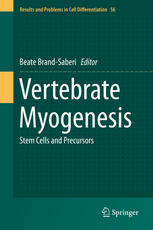

Most ebook files are in PDF format, so you can easily read them using various software such as Foxit Reader or directly on the Google Chrome browser.
Some ebook files are released by publishers in other formats such as .awz, .mobi, .epub, .fb2, etc. You may need to install specific software to read these formats on mobile/PC, such as Calibre.
Please read the tutorial at this link: https://ebookbell.com/faq
We offer FREE conversion to the popular formats you request; however, this may take some time. Therefore, right after payment, please email us, and we will try to provide the service as quickly as possible.
For some exceptional file formats or broken links (if any), please refrain from opening any disputes. Instead, email us first, and we will try to assist within a maximum of 6 hours.
EbookBell Team

4.1
80 reviewsThis book addresses the differentiation control of skeletal muscle in different locations of the vertebrate body Particular attention is paid to novel regulatory molecules and signals as well as the heterogeneity of origin that have revealed a developmental overlap between skeletal and cardiac muscle. Different functional muscle groups are the product of the evolution of the vertebrate classes, making a phylogenetic comparison worthwhile for understanding the role of muscle stem cells and precursors in myogenesis. New insights into the hierarchy of transcription factors, particularly in the context of these different muscle groups have been gained from detailed investigations of the spatio-temporal and regulatory relationships derived from mouse and zebrafish genetics and avian microsurgery. Importantly, epigenetic mechanisms that have surfaced recently, in particular the role of MyomiRs, are also surveyed.
With an eye to the human patient, encouraging results have been generated that identify parallels between embryonic myogenesis and regenerating myofibers due to common regulatory molecules. On the other hand, both processes differ considerably in quality and complexity of the processes employed. Interestingly, the heterogeneity in embryonic sources from which skeletal muscle groups in the vertebrate including the human body take origin is paralleled by differences in their susceptibility to particular muscle dystrophies as well as by the characteristics of the satellite cells involved in regeneration. The progress that has been made in the field of muscle stem cell biology, with special focus on the satellite cells, is outlined in this book by experts in the field. The authors review recent insights of the heterogeneous nature of these satellite cells regarding their gene signatures and regeneration potential. Furthermore, an improved understanding of muscle stem cells seems only possible when we study the impact of the cell environment on efficient stem cell replacement therapies for muscular dystrophies, putting embryological findings from different vertebrate classes and stem cell approaches into context.